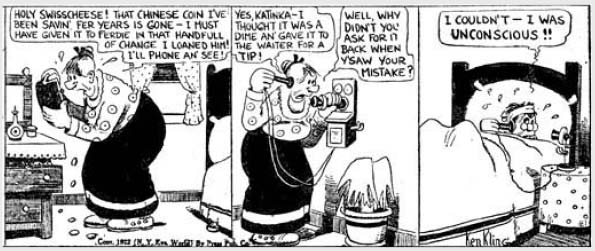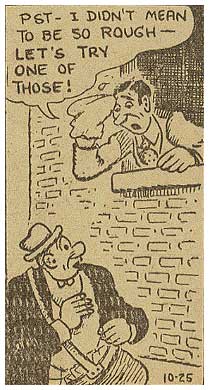Kenneth Kling was an American cartoonist from New York City. On leaving high school, he got a job in a silk house whose main product was ladies' veils, before turning to cartooning. In the first half of the 1910s, he was Bud Fisher's apprentice on 'Mutt and Jeff', doing backgrounds and lettering. Between 1916 and 1922, he made his own feature called 'Hank and Pete' for the National Cartoon Service. It was continued by Ray I. Hoppman from 1922 until the end of its run in 1924. During the First World War, Kling enlisted in the Navy. After the war, he made the comic strip 'Buzz and Snooze' (1918-1919), through McClure Syndicate. During the 1920s, Kling made newspaper features like 'Katinka' in The New York Herald (1920-23), 'Those Folks' (1922-23) and 'Joe Quince' for the Baltimore Evening Sun (starting 1923).
'Katinka'.
'Joe Quince' was renamed 'Joe and Asbestos' in 1924 and ended its first run in 1926. The strip about horse racing earned Kling quite a living, because newspapers were paying Bell Syndicate a fortune to get the exclusive rights to publish the strip in a region. The readers thought Kling was giving handy racing tips in his cartoon, but in truth Kling didn't know a thing about racing when he started the strip. Kling simply let his character Joe pick out real horses for actual races and by coincidence all his picks won.
Kling stopped his feature after a short while, and started the strip 'Windy Riley'. But the public kept thinking that Kling was giving hidden racing tips. 'Windy Riley' was also made into a two-reel comedy, 'Windy Riley Goes To Hollywood' (Educational, 1931). In 1931, Kling revived 'Joe & Asbestos' for the New York Daily Mirror and continued it until a year before his death in May 1970.
'Windy Riley'.
Ink-Slinger profile at the Stripper's Guide
Joe and Asbestos in the Toonopedia





